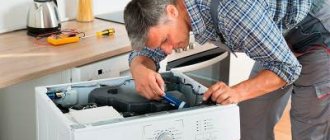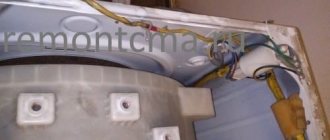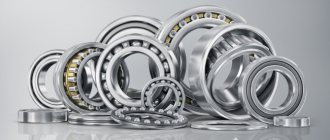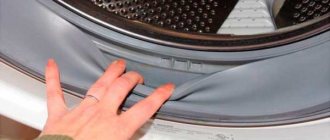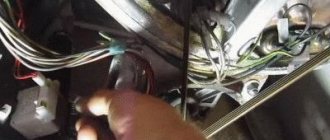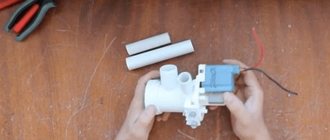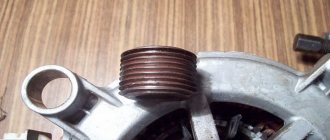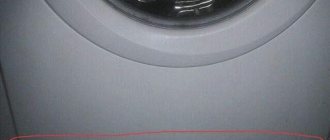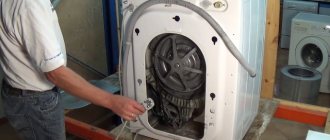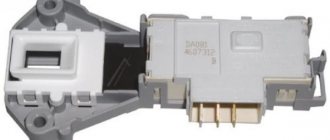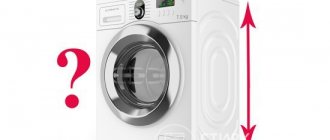Purpose of brushes in a washing machine motor
The operation of an AC asynchronous motor is based on the rotation of a magnetic field, which drives the rotor of the device. It is the rotor that is connected through a belt drive (shaft and pulley) to the drum, ensuring its rotation. Most often, compact electric motors are used, with the ability to adjust the rotation speed.
Currently, most of all household devices are equipped with commutator motors, consisting of a stationary stator, a commutator rotor, a tachogenerator and at least a pair of graphite electric brushes, through which electricity is transmitted to the motor armature.
The commutator motor has a small size, good starting torque, is not tied to current frequency and is easy to control. All these qualities were the reason for their installation in washing units from almost all well-known global manufacturers. It is the presence of quickly wearing and noisy brushes for the electric motor that is noted as a disadvantage of commutator motors.
We disassemble the washing machine
First, let's disconnect our household appliances from electricity. Now let's start disassembling the machine:
- In order to get to the engine, we need to remove the back wall of the washing machine housing. Usually it is attached to several self-tapping screws, which can be easily removed with a regular screwdriver.
- Next we need to remove the drive belt. This is done simply. You just need to pull it towards you while simultaneously turning the pulley with your free hand. Our strap will come off the pulley and remain in your palm.
- Then we remove it from the engine. And put it aside.
- Next we need to disconnect the electric motor from the wires and remove it. In order to disconnect the wires, you need to pull the connector towards you.
- The engine is fixed on any type of fasteners. Typically bolts or screws are used for this. Let's twist them and remove the washing machine motor.
What are commutator motor brushes?
Those who have ever disassembled an electric motor, in a drill, grinder or other household power tool, have seen that electric brushes look like small graphite rectangular cylinders equipped with copper contacts and steel pressure springs. The dimensions and shape of the contact element itself may vary depending on the manufacturer.
Since the surface of an electric brush in contact with a rotating rotor is subject to both mechanical and electrical wear, engineers for their production are developing special combined materials designed to reduce the influence of these negative factors. Currently, commutator electric motors are equipped with brushes:
- copper-graphite;
- carbon-graphite;
- electro-graphite.
Each type contains graphite, which has low electrical resistance and a low coefficient of friction. Due to the low price and excellent characteristics, carbon-graphite elements are installed in the electric motors of washing machines in many models. Modern technologies make it possible to produce high quality brushes that can last 5 years or more.
When to replace motor brushes
Dust particles getting between the carbon brushes and the formation of a spark, combined with the rotation of the engine rotor, leads to their natural wear. This is expressed in a simple change in shape in the form of erased contacts and linear dimensions of the element. As a result of wear, the operation of the electric motor, and as a consequence of the entire washing unit, is disrupted. You can determine brush wear by the following signs:
- noise and crackling noises are emitted from the motor installation location during operation, caused by direct contact of the pressure spring to the rotor commutator;
- insufficient power of the electric motor when the laundry remains wet even at high speeds during spinning;
- sudden stop of washing;
- the appearance of smoke, sparking and a specific burning smell;
- displaying an error code (typical engine malfunction).
In recent years, more and more models of washing machines are equipped with self-diagnosis systems, which allow, without interfering with operation or disassembly, to determine most of the reasons why certain working units fail.
The error codes that appear on the displays of washing machines are different for all manufacturers and are indicated in the technical documentation. For example, for German Bosch washing machines, the designation E or F21 means a problem with the motor, but not always with the brushes. No matter how “smart” the washing machine is, the actual condition of the brushes and commutator can only be determined visually, and this cannot be done without disassembling and removing the engine.
Assembling the washing machine
To assemble the machine we need to do the following:
- Let's return the electric motor to its place and fix it with bolts (or screws, depending on how it is mounted in your model).
- We return the drive belt to its place. First we put it on the engine, and then on the pulley. In order to position the belt correctly, you need to pull part of it onto the pulley. And then, by rotating the pulley and holding the belt, we can complete our task. You can scroll through it a few times to make sure everything is in place.
- Now we connect the wire connectors to the motor.
- Close the back cover and secure it with self-tapping screws.
- Now all we have to do is test run the washing machine.
How to change brushes on an engine - video:
Interesting:
- How to change brushes on a Bosch washing machine
- DIY LG washing machine motor repair
- How to change a bearing in a washing machine
- Repairing and checking the washing machine motor...
- Do-it-yourself repair of faults in Gorenje washing machines
- Drum won't spin in Samsung washing machine
readers
- 02/06/2016 at 21:18
Anonymous:
GREAT VIDEO WITH COMMENTS!!!!!
Answer
- 06/02/2016 at 11:49
Veronica:
Where can I buy these brushes?
Answer
- 06/02/2016 at 11:50
alex:
Tell me the bearing numbers for Atlant 50s124
Answer
- 09/11/2017 at 08:54
Nikolay:
After the drum stopped spinning, I changed the brushes on the motor. And everything worked, but a burning smell appeared - the engine began to heat up. What could be causing this? Engine arcelik 2806850500, machine BEKO WKL 14580 D.
Answer
- 09.26.2017 at 10:48
Sergey:
Perhaps something is preventing the drum from rotating freely, maybe the bearings also need to be replaced
Answer
- 03/20/2018 at 16:06
Vlad:
After replacing the brushes and boring the commutator, the door error remained. I rang the board and found nothing suspicious. And I didn’t find it in UBL, tell me where the problem might be?
Answer
- 03/30/2018 at 22:28
inkogo:
Well, there may be a problem with the door lock... door.
Answer
- 06/03/2018 at 11:50
Dinar:
Hello, I changed the brushes on the Samsung. Now the machine will turn once at high speeds and everything stops. Then it shows an error, what is the reason?
Answer
How to change brushes on a washing machine
Some manufacturers of household power tools list quick-release carbon brushes as advantages of their models. This is really important, because when performing work, time is more valuable than gold, and brushes have to be changed quite often due to difficult working conditions. With washing machines the situation is somewhat different. To assess their condition or replace it, you must:
- Disconnect the power supply to the washing machine from the electrical network, and, if possible, from the water supply and sewerage system, to facilitate repairs;
- Remove the washing machine casing to provide access to the electric motor. For different brands of washing machines, one or more walls have to be removed. Sometimes it is enough to unscrew the bottom. In each specific case, disassembly is carried out with its own procedure;
- Remove the drive belt from the pulley located on the engine rotor shaft;
- Disconnect the electrical wires connected to the electric motor;
- Unscrew the fastening elements of the motor and remove it from the washing machine.
ADVICE! An excellent solution would be if all disassembly operations at each stage are recorded on a smartphone camera. This will make it possible to correctly install all elements and electrical wires when assembling the unit. Remember which direction the brushes are pointing!
After removing the engine, you need to unscrew the brush holder mounting bolts, then disconnect the contact terminals. If the brushes on the motors are less than one and a half centimeters long, or if cracks or broken contacts are visible on them, then they must be replaced.
If only one brush is severely worn or damaged, both parts must be replaced.
Before installing new brushes to replace the old ones, it is necessary to inspect the condition of the stator and rotor, clean them of dust, dirt, and graphite residues using a dry rag soaked in medical alcohol. If there are small scratches and nicks on the contact surface of the commutator (the brushes are adjacent to it), they can be carefully removed using the finest sandpaper, then wiped with alcohol. After all the manipulations, you can install new elements with mandatory reliable fastening using locking bolts.
Having assembled the washing machine in the reverse order of disassembly, you can begin testing. To do this, you need to turn on the washing machine in one of the washing modes (without clothes at idle), and observe the operation of the device. If there is slight sparking and not much noise in the engine, this is normal in the first minutes of operation. Over time, the surfaces of the brushes will rub against the commutator and the sparks will disappear. During the first wash cycles, you should not overload the drum with laundry.
Replacing a brush for a washing machine with your own hands
Brushes are a part that is considered consumable due to wear and tear, so it needs to be replaced in a timely manner. In a large number of washing machines of different models and brands, it is enough to remove only the back panel to replace the brushes, but there are also models that require complete disassembly.
There are also designs in which it is impossible to get close to the motor even after complete disassembly, so you need to take your machine to a service center, where they will disassemble the engine and replace the electric brushes. Prepare your tools in advance before disassembling the washing machine and installing new brushes.
Separating the motor from the drum
The main task is to disconnect the motor from the drum. You need to disconnect the machine from the network, disconnect the contacts and start working on the motor. First make sure that the problem is in the brushes; their wear can be easily detected.
Brushes must be replaced if the length of the used rods on old brushes is from 1.5 to 2 centimeters.
Replacement is due to uneven wear of the rods. It may also be that the rods will wear out faster, so replacement will need to be done after a few weeks.
Distribute all your work in stages in advance, and write it down, or sketch it, or maybe take a picture. This will help you assemble your design correctly, without missing anything, and without mixing up the parts.
We photograph the sequence of work
Before replacing the brushes, first remember their location and in which direction the bevel is located. If they are installed incorrectly, the motor may spark.
You can remove the brushes using screwdrivers, then inspect the motor commutator.
If various types of defects are detected, such as scratches or just dust, they need to be eliminated.
Scratches can be removed with fine-grained sandpaper, and dust can be cleaned with a brush. After this, you can install new electric brushes (preferably original ones), attaching them with self-tapping screws.
If you recorded the progress of your work, then reassembling it will not be difficult for you. After installing the brushes, put the motor in place, securing it, install the electrical wires and cover it with the back panel.
Testing
Once you have installed the brushes and motor, you need to test them to ensure they are working properly and allow the new brushes to settle into place. You can test in the following ways:
- – turn on the machine in spin mode;
- – set and run the fastest washing program.
We recommend that you do not overload the drum with laundry during the first 10-15 washes, since the new brushes of the washing machine should take root in their new place.
Check and change the brushes in the motor in a timely manner and do not forget that your checks should be regular. Lubricate parts and carry out structural maintenance.
If you follow these rules and use the washing machine according to the instructions, then your unit will serve you long and reliably. And if you don't do this, you will cause serious damage to your car, and it will be very difficult to fix them.
How to choose replacement brushes
The functioning of the washing machine and the service life of the graphite elements directly depend on the correct choice of brushes. All brushes must be the same size, since installing parts with different spring stiffness or other material carries a high probability of failure of the entire unit.
You should only buy brushes from trusted sellers, making sure to write down or remember the brand of your washing machine. The easiest way to purchase spare parts is through online stores or service centers. Original products can cost from 800 to 3000 rubles, but to reduce the cost you can buy universal brushes, they cost from 300 to 500 rubles. By purchasing brushes for a specific model, you eliminate the possibility of poor-quality repairs, which are often carried out with mechanical adjustment of the brushes to the required dimensions. Even considering that replacing brushes is not a complex repair, it is better to have it done by specialists who provide a guarantee for the repair.

